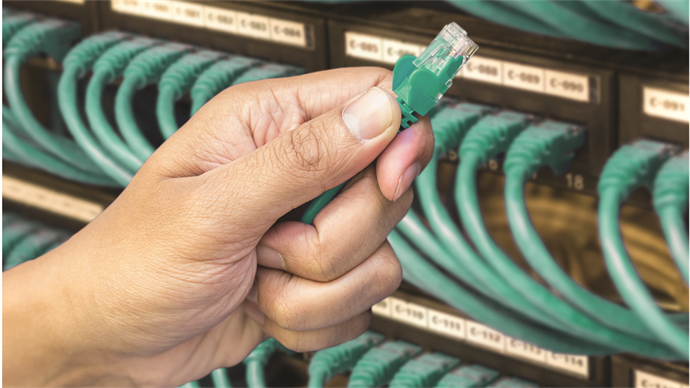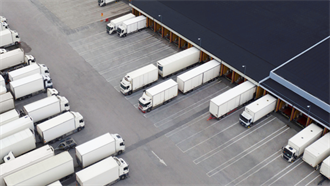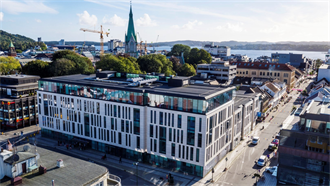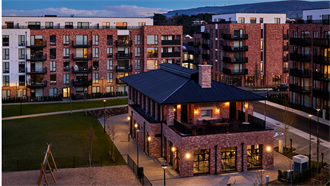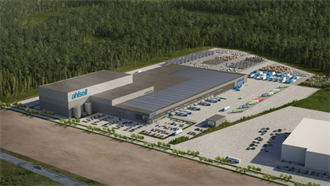Across Europe and mostly out of sight networks of data centres, cell towers and underground fibre-optic cable are moving and crunching vast and rising quantities of data, staving off – until now – the worst impact of a dramatic economic collapse which the coronavirus (Covid-19) pandemic is causing.
Tough restrictions upon freedom of movement are in place to curb infections, meaning digital infrastructure has never been more important in keeping running during this unprecedented time tens of thousands of businesses and millions of relationships. So now seems an apt time to lift the lid on the sector responsible for keeping societies functioning, and to examine the landscape for investors.
Enticing first impressions
‘Cell towers and data centres are perpetual outperformers in periods of economic growth and contraction,’ says Claire Demaine of the Advisory & Consulting team at Green Street Advisors.
‘In the US they outperformed traditional real estate sectors more than threefold over the last five-year period. Since the mid-February onset of the Covid pandemic, they also outperformed on the RMZ index, declining by less than a fourth compared to traditional sectors,’ she says.
Indeed, cell towers and data centres are proving resilient in this current bear market, and also outperform in bull markets – compelling from an investor standpoint. Since March and the onset of the pandemic-induced economic coma, total annualised returns to shareholders in cell tower and data centres are down 10%, compared to an average 25-35% in their peer groups.
Driving this performance in no small part are demand-side factors. In the past decade, internet traffic increased by 30 times in Europe. In the next three years, it is tipped to grow exponentially by another 30 times.
Web traffic growth
Today, smartphones, cloud storage services by Google, Amazon and others, the Internet of Things (IoT), and a galaxy of web-based products all rely upon fibre-optic cable and data centres. Further ahead, future demand seems assured, with 5G technology, artificial intelligence, autonomous vehicles and digital ID requirements for citizens around the globe, all forecaset to require ever more capacity. For example, a one-hour drive in a self-driving car uses as much data as streaming 1,300 hours of video on Netflix.
At present in Europe, supply is keeping pace with demand, with vacancy at 4% in London, according to JLL. But the continent is lagging behind its own target – set by the European Commission – for every person to have broadband access. A total of €100 bn investment per year until 2025 is needed to achieve this ambitious goal, according to the EU body. Hotspots for digital demand are the cities of London, Amsterdam, Paris and Frankfurt. In a rare case of the EU outperforming the US in digital infrastructure, demand in these cities outstrips that in North Virginia, the biggest data centre market in the US.
State of the market
Today, there are 2,600 data centres and 420,000 cell towers and miles of fibre-optic cabling scattered across the continent, with demand expected to keep rising moderately and being met by speculative development.
Proximity Data Centres Limited is in the process of building 18 regional data centres in the UK closer to where businesses operate, in order to cut latency – which is the delay in transferring data between locations. Last month, ICG Longbow loaned Proximity £25 mln (€28 mln) from its £929 mln (€1.53 bn) partnership capital fund, ICG-Longbow UK Real Estate Debt Investments.
In 2019, more than 100 investments were made in co-location centres – which rent out space, equipment and bandwidth – in Europe.
Meanwhile, in the cell tower segment – towers connecting mobile phones to data networks – a big driver of demand has been subscriptions for smartphones. They have grown by a factor of four in 10 years, today comprising 75% of the phone market.
The biggest European pure-player in the sector is Spanish behemoth, Cellnex. Since Covid-19 emerged, returns for the listed firm have slid by 11%, whereas EPRA’s European index has tumbled 32%. The company has recorded total returns of 33% since going public in 2015, also comfortably outperforming the EPRA index.
Meanwhile, fibre-optic networks are attracting interest from investors seeking stable, long-term returns. In February, private equity firm EQT and Canadian pension fund Omers paid €2.8 bn to KKR for German fibre-optic network provider, Deutsche Glasfaser.
Low liquidity
However, digital infrastructure comes with a sizeable ‘but’ for all investors except those with the best connections.
European data centres are 91% owner-operated and there is little liquidity, as owners generally hold on to their assets. Eighty percent of cell towers in the EU are owned by their operators, compared to 16% in the US. Transparency is low, with non-disclosure agreements shrouding in secrecy many data centre deals, for national security reasons.
Another barrier is that the cost of developing assets is as eye-watering as the demand is mouth-watering. In the UK – where land is expensive – fitting a data centre’s power and cooling systems, racks of servers and digital hardware, can cost up to £1,000 (€1,140) per square foot. For a 100,000 sq ft asset, that adds up to a £100 mln (€113 mln) development, even before running costs are factored in, including electricity bills of up to £30 mln (€34 mln) a year.
‘It’s a completely different proposition from a warehouse or delivery centre,’ says Dominic Whitfield, UK director of national logistics and industrial at Savills. ‘The real estate component is maybe 10% of the total cost.
‘So what happens is that the large funds or sovereign wealth funds get involved via a developer-operator, who raises a fund to expand in a region.
‘Many data centre operators are like a REIT. They like the income so they can repay investors and it’s all backed up by a physical asset. Smaller investors are locked out due to the numbers involved.
‘There’s so little leasehold activity in the sector because of pricing and the fact that if you are on a 20-year lease, you could be made to relocate at the end of it; bad news given the infrastructure investment and if you recently replaced the hardware, both of which are major-scale investments.’
So European markets are immature compared to the US; fragmented and with few routes to entry. On the other hand, this is a positive for an investor who can enter the market, consolidate and establish a pure-play European portfolio.
US active in EU
This process is already underway, with north American real estate investors leading the charge in transactions and market development, Digital Realty, Equinix and Cyrus One have an average 23% of their assets deployed in Europe.
In February Blackstone began putting together a new team dedicated to infrastructure in Europe with £12.3 bn to deploy via its Blackstone Infrastructure Partners fund, much of which originates from Saudi Arabia’s sovereign Public Investment Fund. Blackstone has poached Jonathan Kelly from rival Brookfield to lead the fund.
Last December, Brookfield acquired the UK-based cell tower owner, Wireless Infrastructure Group (WIG), buying a 93% stake for €454 mln in the firm which has a portfolio of towers in the Netherlands and Ireland.
Web giant Google is in the process of investing €3.3 bn in European data centres, bringing to €15 bn the company’s total investment in the EU since 2007, in part to meet demand for cloud storage which is worth approximately €200 bn on the continent.
Efforts are being made to open the market by building connections between investors and developers. Di2 is an international organisation based in Germany which connects the two groups at events. It is backed by institutions such as the World Bank and EU Commission, and firms such as Keppel from Singapore.
Di2 co-founder, Nico Grove says: ‘Time has definitely proven we haven’t developed enough digital infrastructure for the future. The market has changed and people now know it is a less risky investment.
‘Someone has to build because there is nothing without the bricks and the passive elements, which is good for the operators. Also, if you’re into risk then there are higher margins available.’
Sharing is caring
If Europeans are to enjoy the benefits of 5G, then infrastructure sharing is going to be important. This is because 5G networks handle 1,000 times more traffic than today’s networks and run around 10 times faster. This output is achieved by multiplying the number of cell towers and data centres, shortening physical distances between units and resulting in faster speeds. As always, the sector is engaged in a never-ending struggle against latency, in which 5G is set to raise the stakes yet higher.
At present, Europe lags in sharing, as revealed by the co-location ratio for cell towers. This is the number of mobile network operators (NMO) sharing one tower, up to a maximum of three. In the US the ratio is 2.2, while in Europe it is down at 1.3, according to EY.
This also hits the sector’s bottom line because the higher the co-location ratio goes, the better it is for returns. Regulators are pushing for infrastructure sharing because it will boost returns by creating rental revenue. But there is scant confidence the EU will get up to the level of the US.
‘Looking ahead, cell tower and data centre investment opportunities in Europe seem attractive, says Demaine of Green Street Advisors. ‘Data consumption is expected to grow exponentially, and cell towers and data centres are critical components of the digital ecosystem that enables consumption at ever-greater volume and speed.
‘Against the favourable demand backdrop, European supply remains fragmented and owner-operator models are prevalent. The door is open for operators to unlock valuation arbitrage to free up investment capital and for real estate investors to generate early-mover returns.’
European firms appear to be waking up to the opportunity of freeing up capital presently trapped in assets in order to invest in innovation to stay competitive.
UK telecoms giant Vodafone is in the process of floating its European phone mast business, for between €15-€20 bn. It is spinning the network off into a business called TowerCO, which is due to launch in May. Vodafone’s network comprises 61,700 masts across Europe, with 75% in Germany, Spain, the UK and Italy. TowerCO is set to be one of Europe’s biggest tower firms, generating €1.7 bn of predicted income on renting space on the network to rival providers.
Market consolidation?
Some are sceptical there is great scope for market consolidation in digital infrastructure, questioning why a data centre developer would get into the equally complex task of laying underground fibre networks. Nonetheless, some consolidation is taking place.
NTT Ltd, the European subsidiary of Japanese conglomerate, Nippon Telegraph and Telephone Corp, has recently executed a mega-merger by bringing together 31 companies under its umbrella. Responsible for developing the ‘emoji’ used in text messaging, the global operator’s activities straddle every segment in digital infrastructure.
In January, Cellnex paid €800 mln to buy 3,000 towers and sites in Portugal from OMTEL. The deal also includes 400 new sites in the Iberian country to be developed over the next four years, at a cost of €140 mln.
Last December, French telecoms giant Orange sold its network of 1,500 phone masts to Cellnex for $260 mln. Cellnex also purchased Cignal in
Ireland for €210 mln in October last year and paid around $2 bn for the telecommunications business of the British firm, Arqiva.
Cellnex has ambitious plans to buy up to 28,000 assets, and to roll out 600 new sites by 2026. In the past 12 months, the company increased by 25% the number of Distributed Antenna Systems (DAS) and small cell antennas which it operates, as part of an investment programme totalling almost €4 bn, in preparation for 5G.
Focusing upon the Internet of Things and smart cities in the form of security and emergency service networks and urban infrastructure management last year earned Cellnex almost 10% of its total revenue from infrastructure services of €699 mln.
Slowly, the digital infrastructure sector in Europe is opening up and it promises fertile ground for deep-pocketed investors with the appetite to hurdle high entry barriers.

